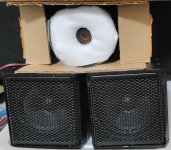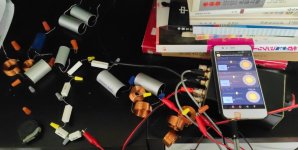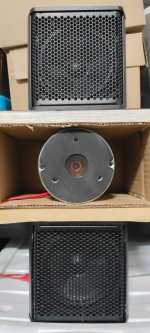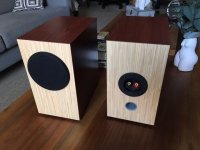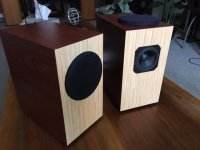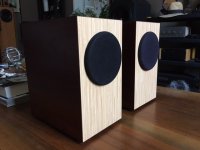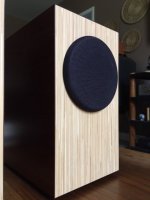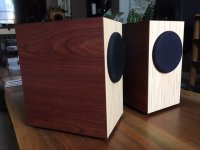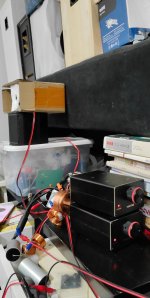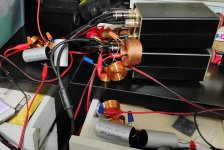Surprisingly or not, with the Minmeh I can hear the comb-filtering pattern dave has often posted. From ~3m away slightly off-axis ~0.4m, ear angled for maximum acuity, the sweet spots are ~10cm apart shifting (head) horizontally, or ~20cm forward/back. At these nodes the music is more open and realistic, presumably due to very high frequency present; away sounds a (very) little duller, less micro-dynamic contrast. I first noticed this when, each time I thought it sounded A+, with a head-sway it no longer was.
How to reduce horn/mouth/throat diffraction combing? VHF should be throat?
Combing is eliminates completely if the spacing between 2 drivers playing the same frequency are a quarter wavelength centre-to-centre. As distance increases combing gets worse. Given the spacing you have XO would need to be very low and th etweeter likely can’t go near low enuff.
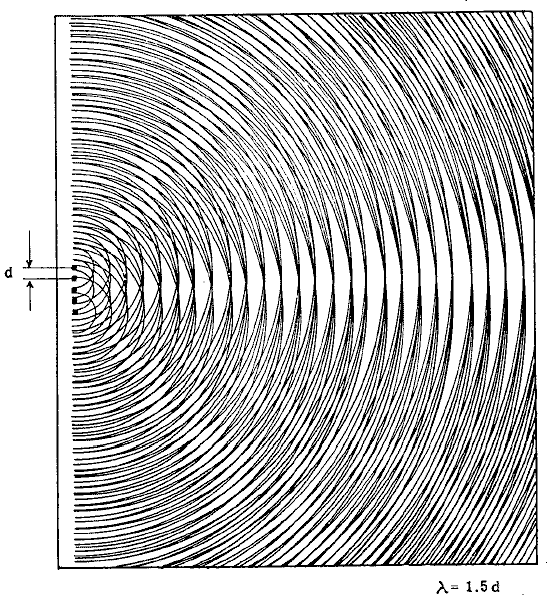
Toole'’s work suggests it is not near as audiable as they look. From Taylor: http://p10hifi.net/planet10/TLS/downloads/taylor-line-array.pdf
dave
How to reduce horn/mouth/throat diffraction combing? VHF should be throat?
Can you do anything about combing?
Combing is eliminates completely if the spacing between 2 drivers playing the same frequency are a quarter wavelength centre-to-centre. As distance increases combing gets worse. Given the spacing you have XO would need to be very low and th etweeter likely can’t go near low enuff.

Toole'’s work suggests it is not near as audiable as they look. From Taylor: http://p10hifi.net/planet10/TLS/downloads/taylor-line-array.pdf
dave
Last edited:
Happy to report issue resolved with Art's diagnosis:

Then the HF driver's output will diffract across the large flat square surface around it, the diffraction will reflect off the horn walls, the multiple arrival times from those reflections...
Pretty good now, ~35° horizontal coverage of flat FR to 12khz that I could hear (Faital HF108 exit angle being 31°). My cost was ahem $220 for eight used drivers (CD, Faital-inside, 12" Aura) plus significantly more than that for the Jantzen aircores and silver zcaps which I reuse for diy-of-the-day.
If this is what your MEH horn looks like:So I prototyped a single Minimalist MEH (Minmeh) using Faital HF108/2x4" and passively filtered the response quite flat 160hz-12khz. Sounded A+ until I swayed my head laterally -- just a couple inches -- then it became noticeably dull/flat -- and a couple inches further -- lively sound came back -- and so on and on. Classic comb-filtering?
Then the HF driver's output will diffract across the large flat square surface around it, the diffraction will reflect off the horn walls, the multiple arrival times from those reflections...
Pretty good now, ~35° horizontal coverage of flat FR to 12khz that I could hear (Faital HF108 exit angle being 31°). My cost was ahem $220 for eight used drivers (CD, Faital-inside, 12" Aura) plus significantly more than that for the Jantzen aircores and silver zcaps which I reuse for diy-of-the-day.
Attachments
Update: MEH vs offset TMM.
Speaking for the OP and myself -- MEH has much wider VHF dispersion & sweet-spot than the tweeter. Where I (likely) assign a "demerit" to mine is lack of soundstage depth -- coherent time and phase aligned speakers (1ch or 2ch) would project the musicians beyond the wall, rather than in the room; also a "holographic" sense of "air" and venue space. I hope @m-a DSP filter achieved this.
@mayhem13 suggested MTM so I thought I would take a few minutes to rearrange the Faital drivers and listen to both music & tone-sweep. Of course it turned into a weekend project....
First I determined the (hornless) HF108 faceplate and LDA-401 grille time-offset to be ~2cm (without XO) and tweaked MTM (beware magnetic attraction!) to work well enough but only by reversing polarity, achieving phase-alignment (by ear) while sacrificing time-alignment by 1cm offset. This imaged better than the MEH but I was not completely satisfied. (Note: by carefully poking a bent-paperclip through the LDA-401 grille I measured 1.25cm to the driver surround.)
Figuring 1khz 1/4WL 8.5cm, I rearranged the drivers into T/MM pyramid (CtoC ~12.5cm) and tried crossing low. Long story short, I didn't like 2nd-order phase/imaging (2cm+12R->4.7uF/0.3mH, 0.3mH/8.6uF). Back to 1st-order with a 2-5khz broad notch filter just like the MEH but tweaked HP/LP to match phase as much as possible (2cm+14R->4.7uF->3.9uF||0.62mH, 0.3mH).
Importantly, I learned the hard way that the 31° exit-angle HF108 would spread >10khz very high frequency more broadly than a hard dome tweeter and the HF/VHF reflected strongly off its faceplate to mess up phase and FR. I made a soft absorber/waveguide out of folded antistatic wipe (wool worked better but I didn't want to hole old scarfie). The mess of XO bits chained with electrician's twist caps allowed me to test different value combinations just by moving alligator clips. Finger tone-sweep and loudness-comp up to three frequencies using APP Frequency Sound Generator; listen to test music for faint transcient detail and size/depth specificity (just 1ch, ear on-axis angled ~30° lined up using 11khz tone), ideally well-focused "beyond the wall".
I think, with 9mH->12" Aura over a tall closed tube this combo could be a candidate for A+/A+/A+.
good ol vertical MTM with Scanspeak midwoofers and tweeter will outperform the compact MEH
Speaking for the OP and myself -- MEH has much wider VHF dispersion & sweet-spot than the tweeter. Where I (likely) assign a "demerit" to mine is lack of soundstage depth -- coherent time and phase aligned speakers (1ch or 2ch) would project the musicians beyond the wall, rather than in the room; also a "holographic" sense of "air" and venue space. I hope @m-a DSP filter achieved this.
@mayhem13 suggested MTM so I thought I would take a few minutes to rearrange the Faital drivers and listen to both music & tone-sweep. Of course it turned into a weekend project....
First I determined the (hornless) HF108 faceplate and LDA-401 grille time-offset to be ~2cm (without XO) and tweaked MTM (beware magnetic attraction!) to work well enough but only by reversing polarity, achieving phase-alignment (by ear) while sacrificing time-alignment by 1cm offset. This imaged better than the MEH but I was not completely satisfied. (Note: by carefully poking a bent-paperclip through the LDA-401 grille I measured 1.25cm to the driver surround.)
Figuring 1khz 1/4WL 8.5cm, I rearranged the drivers into T/MM pyramid (CtoC ~12.5cm) and tried crossing low. Long story short, I didn't like 2nd-order phase/imaging (2cm+12R->4.7uF/0.3mH, 0.3mH/8.6uF). Back to 1st-order with a 2-5khz broad notch filter just like the MEH but tweaked HP/LP to match phase as much as possible (2cm+14R->4.7uF->3.9uF||0.62mH, 0.3mH).
Importantly, I learned the hard way that the 31° exit-angle HF108 would spread >10khz very high frequency more broadly than a hard dome tweeter and the HF/VHF reflected strongly off its faceplate to mess up phase and FR. I made a soft absorber/waveguide out of folded antistatic wipe (wool worked better but I didn't want to hole old scarfie). The mess of XO bits chained with electrician's twist caps allowed me to test different value combinations just by moving alligator clips. Finger tone-sweep and loudness-comp up to three frequencies using APP Frequency Sound Generator; listen to test music for faint transcient detail and size/depth specificity (just 1ch, ear on-axis angled ~30° lined up using 11khz tone), ideally well-focused "beyond the wall".
I think, with 9mH->12" Aura over a tall closed tube this combo could be a candidate for A+/A+/A+.
Attachments
Last edited:
Update: MEH vs offset TMM.
Update2: I misplaced the second pair of mids array units so I've had to downgrade to just offset TM -- and accidentally made a further improvement bi-amping (no resistor-chain). HF108 padded faceplate back-offset 5mm from (putative) 4FE35 surround apex. HP: 4.7uF->3.9uF||0.62mH; LP: 0.9mH; level matched by ear 1khz vs 8khz test-tones. Flat smooth FR; time alignment & phase matching evidenced by transcient detail/dynamics and sense of air (venue background reverberant radiation). The last mm of offset alignment should be set carefully by ear, as even a 0.5mm nudge would likely kill the air and reduce image focus/depth. This step is precise and repeatable -- unreasonably so -- 0.5mm being just 1.5us (microsecond), about the limit of what John Dunlavy could measure for his Magnus DSP project (see old Stereophile interview).
Anyone with these common drivers, please give it a try!
A+/A+/above ~140hz closed ~1L. Much wider VHF dispersion and sweet-spot than fullrange drivers or vanilla 1" dome tweeters. It would be very nice to have a super compact 40-140hz subwoofer.... Ideas anyone?
Attachments
Last edited:
View attachment 1324804View attachment 1324801
This is "Z", my latest speaker project, there as a thread about bass mid drivers that could be run ragged, without a crossover so I though of what I would use, and a woven glass fibre seemed a good bet, so I looked on line and found "blow" drivers that were cheap, hence this project. I did consider posting in the multi way section, but as the driver is effectively full range with a fill in tweeter I've posted it here. The front, bottom and rear are 18mm MDF, the sides and top are 3.4mm ply, with felt, then carpet tile glued on the inside to both dampen mechanical vibration and to stop sound from passing through. The Z comes from the internal baffle designed to stop reflections from the rear of the cone, and the space behind them is packed with cotton wool, and there's vents to give some aperiodic damping effect, the stands are hollow to increase the volume and I might put a restrictive vent between the speaker and stands. The tweeter come in at about 8,000 hz, it needs to be padded down a lot. I was a bit disappointed with the sound, but as the drivers loosen up they keep getting better.
A bit of an update on my Z speakers, I've tried them with a rear firing tweeter, and found that it worked best with a second order crossover, so I presumed that the main driver naturally rolls off in a second order, so I tried a notch filter to try and get the main driver to roll of in a first order slope, and used a front firing tweeter with a first order filter; this worked really well but the music lacked emotion. I guessed that this might be because of the woven glass fibre driver, so I tried a paper coned driver (without a notch filter) - this real hit the spot, it sounds sublime. Not having an inductor on the main driver certainly helps with bass dynamics, the speaker is incredibly detailed and great at replicating the timbre of instruments. I was sceptical of blending a tweeter at such a high frequency (around 8,000Hz), but the directional qualities of the bullet tweeter must match very well with the beaming of the main driver at high frequencies.
The drivers are DS18 BULLET PRO-TWX1 tweeter (£12.99p a pair)
mid bass - QTX 902.536UK (£8.00p each)
It seems stupid that my best speakers are so simple, and use really cheap drivers.
They are slightly lacking in bass, but I think if they were close to a wall and with bigger stands (as the stands are part of the cabinet volume) it would help a lot.
My Markaudio DIY loudspeakers with constrained layering panels.
1.9 cm mdf with bitumen + 1mm + 1.9 cm oak sides.
This is the best sound I have had for many years , using chn110 . Cabinet tuned to 35 Hz , port on the rear.
The speakers are heavy , 40 kg each.

1.9 cm mdf with bitumen + 1mm + 1.9 cm oak sides.
This is the best sound I have had for many years , using chn110 . Cabinet tuned to 35 Hz , port on the rear.
The speakers are heavy , 40 kg each.
- Home
- Loudspeakers
- Full Range
- Full Range Speaker Photo Gallery

